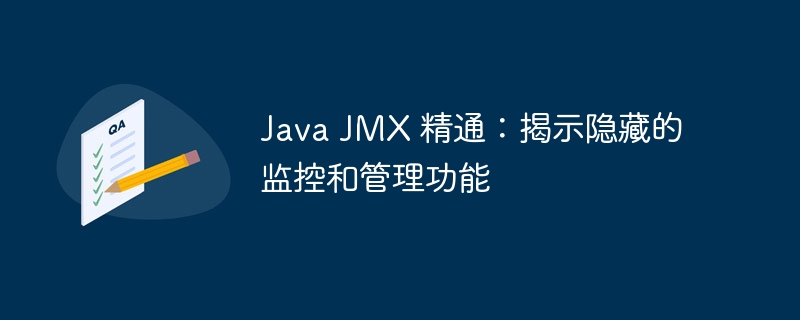

Java JMX is the abbreviation of Java Management Extensions and is an important tool for monitoring and managing Java applications. In Java development, proficiency in JMX technology can help developers better monitor and manage applications. This article will reveal the hidden monitoring and management capabilities of Java JMX and help readers gain a deeper understanding of how to use this powerful tool to improve application performance and stability. This article is carefully written by PHP editor Youzi, hoping to provide useful reference and guidance for the majority of Java developers.
JMX is a standardized set of api for monitoring and managing Java applications. It allows applications to expose their internal state and behavior and provides a mechanism to dynamically configure and modify these aspects. The core concept is MBean (Managed Bean), which encapsulates the information and operations of managed objects.
MBeans follow a hierarchical model and contain the following types:
MBeanServer:
The central component for managing MBeans is MBeanServer. It is responsible for registering, unregistering, and finding MBeans, and handling requests from management applications. Applications can interact with MBeanServer through the JMX API.
Sample code:
The following code shows how to register a standard MBean using the JMX API:
// 创建 MBean StandardMBean mbean = new StandardMBean(new MyMBean(), MyMBean.class); // 注册 MBean MBeanServer mbs = ManagementFactory.getPlatfORMMBeanServer(); String objectName = "my.domain:type=MyMBean"; mbs.reGISterMBean(mbean, ObjectName.getInstance(objectName));
Advanced usage
JMX provides a wide range of advanced features, including:
Sample code:
The following code shows how to use MBeanServerConnector to remotely manage JMX:
// 创建 MBeanServerConnector
MBeanServerConnector connector = new MBeanServerConnector();
connector.start();
// 获取连接器地址
String connectorAddress = connector.getAddress();
// 远程管理应用程序
JMXServiceURL url = new JMXServiceURL("service:jmx:rmi:///jndi/rmi://" + connectorAddress + "/jmxrmi");
JMXConnector jmxc = JMXConnectorFactory.connect(url);
MBeanServerConnection mbsc = jmxc.getMBeanServerConnection();advantage
Using JMX provides the following advantages:
in conclusion
JMX is a powerful tool for monitoring and managing Java applications. By mastering its core concepts and advanced usage, developers can unleash its full potential, gain deep insights into application behavior, and effectively manage its runtime behavior. Leveraging the capabilities of JMX can significantly improve the stability, scalability, and maintainability of your applications.
The above is the detailed content of Java JMX Mastery: Revealing Hidden Monitoring and Management Capabilities. For more information, please follow other related articles on the PHP Chinese website!
 teambition
teambition
 Usage of write function
Usage of write function
 What are the requirements for Douyin live broadcast?
What are the requirements for Douyin live broadcast?
 The difference between UCOS and linux
The difference between UCOS and linux
 What are the commonly used instructions in vue?
What are the commonly used instructions in vue?
 How to solve the problem that js code cannot run after formatting
How to solve the problem that js code cannot run after formatting
 How to jump with parameters in vue.js
How to jump with parameters in vue.js
 What does mobile phone hd mean?
What does mobile phone hd mean?




